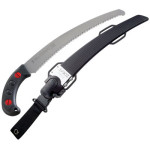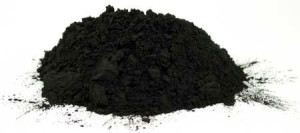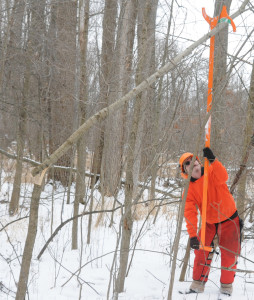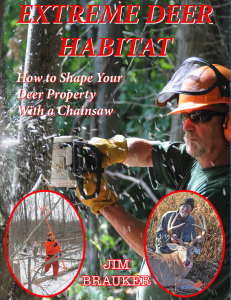I have no sponsors.
Anything I use is something that I really do use, it is not something that someone pays me to say I use.
I put this list here just to highlight some products that I think will be useful to my clients and followers. That’s it and that’s all.
Here is a list of things I use and where you can get them.
HABITAT TOOLS:
Silky  handsaws. Every landowner should have a high quality hand saw. Silky is the best brand of saw I have used. I recommend, for all around habitat work, the Silky Zubat 330.
handsaws. Every landowner should have a high quality hand saw. Silky is the best brand of saw I have used. I recommend, for all around habitat work, the Silky Zubat 330.
Available from:
Hinge Tools: A good hinge tool is critical for successful hinge cutting. The hinge pole allows the cutter to stop cutting before the tree releases and push it or pull it over with the pole.
Links:
ACTIVATED CARBON AND ZEOLITE: These powders are an absolutely essential part of my scent control program. I use activated carbon powder to treat my equipment and to treat the outside of my boots as recommended in my book and videos. I use zeolite powder on my skin, especially the hair, armpits and groin, and to treat the inside of my boots.
 Activated Carbon: Activated carbon is available from many sources. I recommend buying food grade activated carbon fine powder. One example comes from Starwest Botanicals: LINK. To view other pricing and volume options, do a search on Amazon.com using the words activated carbon powder. LINK: Activated Carbon Powder on Amazon.
Activated Carbon: Activated carbon is available from many sources. I recommend buying food grade activated carbon fine powder. One example comes from Starwest Botanicals: LINK. To view other pricing and volume options, do a search on Amazon.com using the words activated carbon powder. LINK: Activated Carbon Powder on Amazon.
Zeolite Powder. Zeolite powder is available here: LINK
 ACTIVATED CARBON MASKS: Filters the breath. I will not hunt without one. The mask tops off the scent control program. Available from I can Breathe. Make sure you buy the Honeycomb Mask with Classic Filter not the “Sport” mask which filters only incoming air.
ACTIVATED CARBON MASKS: Filters the breath. I will not hunt without one. The mask tops off the scent control program. Available from I can Breathe. Make sure you buy the Honeycomb Mask with Classic Filter not the “Sport” mask which filters only incoming air.
I have a surplus of these masks in the original packages that I can sell for a limited time only. Call me at 858-449-5178. These are priced at $25 for the mask plus one filter and $27 for a 5-pack of filters. Cheaper than buying from them because I bought before the filter prices were raised. Six filters are enough to last me for 50 plus hunts per year.
Goose Call:



Hi Jim,
How do you deal with wasp, hornet and yellow jacket nests when they are in areas you need to clear?
Thank you!
Kelly
I buy wasp and hornet spray and kill them with it. You can get the kind that shoot a stream a long distance. If it is a large nest you may have to hire a professional.
What kind of chainsaw do you use and recommend? Thanks!
Thanks for putting the book out. I just bought my little slice last december and have been hard at work. Jim what do you think of the breath taker disposable mask made for hunting??
I am not a fan. They are cheap disposables. A better option is the nylon masks from icanbreathe.com. The mask is permanent sand is used with a disposable cartridge that contains far more carbon and is the unit is much more face fitting. You pay a lot more but you get a lot more.
Thanks for the input on the mask. I have another question based on your book, I have read it and went back to it many times throughout this spring and summer. I bought 47 acres in december I put 2 mid size plots in this summer (about 1.5 acres total which after next year will be about 3 acres) and have laid it out for bedding transitional plots etc. I am pretty much the only one doing the work so its going to take me probably 3 years to do all of it. What would you suggest next? Should I do the transitional plots or work on the bedding areas??
In my view bedding is much more important. You need to know where bedding is and be between there and the food. Smaller plots in transitional areas can be added later, but they will still use the transitional areas to get to the food, but with perhaps a delayed time frame compared to when you get the small plots in place.
Doc,
Went to icanbreathe.com and still not sure what I should order…..
Honeycomb with Classic filter. Do not buy in blue as deer see exceptionally well in that wavelength. To not buy one with a vale as it lets air out.
Awesome info! I’m trying to find the zeolite powder through the link you provided but it isn’t working. Can you give any detail as to what you look for in a zeolite powder in the case that I need to look elsewhere?
Thanks!
Hi Jim,
Just read your book. Great information. In areas of mature forest (mostly oak for me) that have transition zones going through them, I would like to make the other areas of the woods thicker, without cutting all of the trees down. What percent of the canopy do you need to open up to stimulate the understory to grow? How do you choose which trees to cut? I am not using any of the trees for timber value. I also want to keep the deer using the transition trails that go through this area, Just want the rest of the woods to be thicker so the deer can’t see as far.
Sincerely,
Matt
Hi Matt; Unfortunately I cannot answer your question without asking 20 other questions first. How much you cut and where depends upon your overall management plan and how you want deer to move on your property. I do one hour phone consultations with a shared video screen. If you are interested contact me for details. drjim@extremedeerhabitat.com
Do you have a list of the specific species of plants you use to put in your food plots? I know there are different mixes of clover, rape seed, beats etc…Just wondering if you have a list of favorites.
What foods to plant are area dependent. But variety is the key. Variety in a single plot and variety from one plot to the next. In any given year most of my planting is done in early August. At that time I will more than likely include: Varieties of brassica/rape, purple top turnips, ground hog radishes, kale, crimson clover, wheat, rye and winter peas. I also plant soy beans and corn in August. The corn is planted as a cover crop for other things because as things green up the deer will hammer the corn first, letting the other plants get purchase to grow. Perennials include varieties of clover and alfalfa (it makes no sense to me to plant a single variety in one spot, let the deer figure out what they want), plus chicory. In spring I may plant RR corn, beans and sugar beets, and buckwheat and rye if it is ground I am trying to reconstitute. Never buy seeds that have a picture of a deer on the bag. Always try to buy local seeds whenever possible. They are the ones being used by your local farmers and they are tuned varieties for your areas unlike the ones in the bag that was packaged in Alabama for sale everywhere. Again, anytime you are spreading a single seed over a food plot you are limiting your opportunities. Lighten up on each variety or type of seed and mix different similar-sized seeds together to create variety. Did I mention there are three things that are most important? They are variety, variety, and variety in that order.
Thanks for the quick response. We’ve had good luck with seed from our local co-op, so we will continue that trend. Thanks for the insight.
I have a poplar growth from a 5 year old clear cut. One of the things I would like to do is screen off a road and property edges for access into hunting areas. Saplings are approx 3″ to 4″ in diameter. I have found the poplar a little difficult to hinge for screening without breaking but wanted to get your opinion of whether I should hinge parallel or perpendicular to the road and property line as I screen? Another thought would be to cut them off to get new growth and hopefully thicker growth. Most of it is already pretty thick currently. Thanks Dr. Jim
Poplars are very difficult to keep intact and the tree will rarely stay live even if you produce a good hinge. My advice is to hinge them and pull them over as slowly and carefully as possible. If you are only going to make the screen 5-10 yards wide, I would cut parallel with the road as much as possible. Better would be to cut 30 yards wide at least and then they should be hinged high, medium and low and in all directions. Leave the tops in place and that will facilitate new growth as the tops will inhibit deer browsing but plenty of light will still get in. If they break off, you can make a notch in the stump and raise the butt of the cut tree back up on the stump to create horizontal cover.
Hey Jim, I bought your book and you have truly opened my mind to understand what deer want and need in bedding areas and transition zones. I love it and I keep reading it over and over again. I live in NH were we have really long and hard winters. I was wondering what do you recommend planting to get the deer through the winter?
-Thank you
It is hard to say without seeing your whole property plan. If you are in a region where deer yard there is not a lot you can do unless they are yarding on your property.
Hi Dr Jim,
I bought your book last Christmas. It’s amazing. Really. I just received my saw and habitat hook also. I tried many of my friends to take a look into it so that we could manage our different hunting territories, here in Québec, Canada. However, my hunting buddies all speak french and barely understand english. Have you tought about a french version of your book?
It would bring a lot to the quality of the deer management here, with approximately 150 000 deer hunters.
Thank you,
Nicholas
Thanks for the interesting comment though and I am truly sorry I cannot do more to help those French-only speaking hunters in Quebec, where between 50 and 60,000 whitetails are killed each year. I would love to do so but it would be very expensive as the book was written as a fixed layout so the entire book would have to be relaid out page by page as the number of words per page etc. would change. Moreover, a big part of the book is the 48 videos, all of which are in English. I understand that about 50% of Quebec citizens are French-only but it would be cost prohibitive for me to translate the book in the form it is in.
Hi Jim,
Jake visited my 56 acres near Pike Co, IL last month and I was impressed. How can I schedule your services for hinge cutting as soon as your schedule allows?
Thanks,
Rick
What kind or type ozone generator should I get?
I have not bought one in many years. I would post up on forums or do a search on hunter forums.
Good morning Dr. Jim do you still do online consulting of a property? If so how much and how long for the final layout after talking to you for an hour or so?
Thanks for your time.
Alex